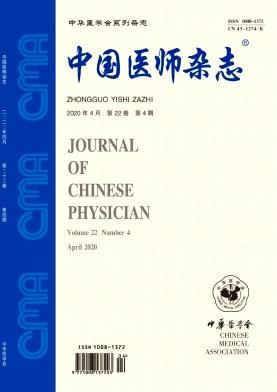Relationship between cerebral hemorrhage and depression occurrence after craniocerebral injury surgery
Q4 Medicine
引用次数: 0
Abstract
Objective To explore the relationship between cerebral hemorrhage and the occurrence of depression after craniocerebral injury surgery. Methods From March 2015 to March 2017, 70 patients with craniocerebral injury in our hospital were selected as the subjects of study. They were divided into the observation group (n=30) and the control group (n=40) according to whether there was cerebral hemorrhage after operation. The National Institutes of Health Stroke Scale score (NIHSS), Hamilton Depression Scale score (HAMD), Glasgow Coma Score (GCS) and the levels of interleukin (IL)-1, IL-6 and high sensitivity C-reactive protein (hs-CRP) in patients with different degrees of cerebral hemorrhage were compared. The correlation between HAMD score and other indexes was analyzed. The influencing factors and independent risk factors of depression were analyzed. Results The levels of NIHSS, HAMD score and serum IL-1, IL-6 and hs-CRP in the observation group were higher than those in the control group after operation (t=13.655, 36.587, 45.274, 46.334, 70.489, P<0.05), while the GCS score was lower than that in the control group (t=15.517, P<0.05). Compared with mild and moderate cerebral hemorrhage, the NIHSS, HAMD scores and serum IL-1, IL-6 and hs-CRP were higher in patients with severe cerebral hemorrhage (F=8.825, 10.254, 23.615, 18.745, 7.245, P<0.05) , while the GCS score was lower (F=7.459, P<0.05). The correlation analysis showed that the postoperative HAMD score was positively correlated with NIHSS score and serum IL-1, IL-6 and hs-CRP (r=0.289, 0.364, 0.333, 0.258, P<0.05) and negatively correlated with the GCS score (r=-0.276, P<0.05). Univariate analysis showed that the level of culture, personality, cerebral hemorrhage degree and serum IL-6 and hs-CRP were the influencing factors of postoperative depression in patients with craniocerebral injury (t or χ2=6.076, 6.300, 8.361, 30.224, 99.575, P<0.05). Multivariate analysis showed that cerebral hemorrhage and hs-CRP were an independent risk factor for postoperative depression (P<0.05). Conclusions Cerebral hemorrhage after craniocerebral injury is closely related to the occurrence of depression, which may be related to the increase of stress-induced inflammatory factors after cerebral hemorrhage. Key words: Craniocerebral trauma; Postoperative hemorrhage; Cerebral hemorrhage; Depressive disorder颅脑损伤术后脑出血与抑郁的关系
目的探讨颅脑损伤术后脑出血与抑郁症发生的关系。方法选取2015年3月~ 2017年3月我院收治的70例颅脑损伤患者作为研究对象。根据术后是否发生脑出血分为观察组(n=30)和对照组(n=40)。比较美国国立卫生研究院卒中量表评分(NIHSS)、汉密尔顿抑郁量表评分(HAMD)、格拉斯哥昏迷评分(GCS)及不同程度脑出血患者白细胞介素(IL)-1、IL-6、高敏c反应蛋白(hs-CRP)水平。分析HAMD评分与其他指标的相关性。分析抑郁症的影响因素及独立危险因素。结果观察组患者术后NIHSS、HAMD评分及血清IL-1、IL-6、hs-CRP水平均高于对照组(t=13.655、36.587、45.274、46.334、70.489,P<0.05), GCS评分低于对照组(t=15.517, P<0.05)。重型脑出血患者NIHSS、HAMD评分及血清IL-1、IL-6、hs-CRP评分均高于轻中度脑出血患者(F=8.825、10.254、23.615、18.745、7.245,P<0.05), GCS评分低于轻中度脑出血患者(F=7.459, P<0.05)。相关性分析显示,术后HAMD评分与NIHSS评分及血清IL-1、IL-6、hs-CRP呈正相关(r=0.289、0.364、0.333、0.258,P<0.05),与GCS评分呈负相关(r=-0.276, P<0.05)。单因素分析显示,培养水平、个性、脑出血程度、血清IL-6、hs-CRP是颅脑损伤患者术后抑郁的影响因素(t或χ2=6.076、6.300、8.361、30.224、99.575,P<0.05)。多因素分析显示脑出血和hs-CRP是术后抑郁的独立危险因素(P<0.05)。结论颅脑损伤后脑出血与抑郁症的发生密切相关,抑郁症可能与脑出血后应激性炎症因子的增加有关。关键词:颅脑损伤;术后出血;脑出血;抑郁症
本文章由计算机程序翻译,如有差异,请以英文原文为准。
求助全文
约1分钟内获得全文
求助全文

 求助内容:
求助内容: 应助结果提醒方式:
应助结果提醒方式:


